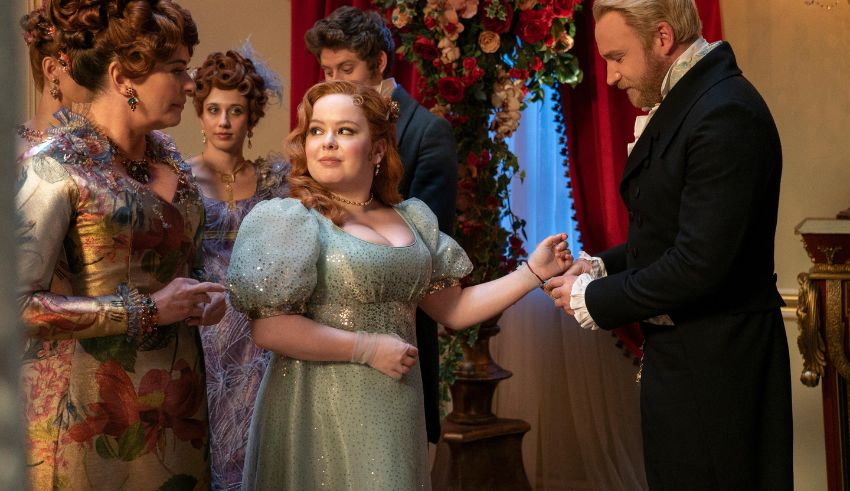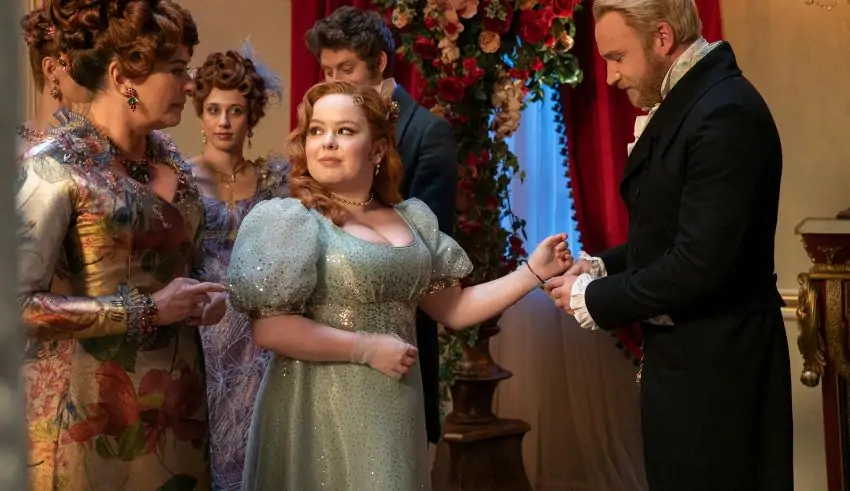

(C) Bridgerton FB
“Bridgerton,” Netflix’s hit series, is as much a visual feast as it is a narrative one. In Season 3, the costumes are not just garments but a language of their own, conveying secrets and sentiments of the characters. Let’s unravel the tapestry of colors and what they signify.

The iconic ‘Bridgerton blue’ continues to dominate the family’s wardrobe, symbolizing their noble status and wealth. This shade, reminiscent of Wedgewood blue, is strategically used to subconsciously associate the Bridgertons with affluence and class. The blue palette not only reinforces their social standing but also highlights the unity and harmony within the Bridgerton family. Each member, from the matriarch Lady Violet to the youngest, carries this color, tying them visually together and emphasizing their familial bonds.
Lady Violet Bridgerton often wears elegant gowns in shades of blue that signify her status as the family matriarch. Her dresses, adorned with delicate lace and intricate embroidery, reflect her sophistication and the Bridgerton family’s longstanding nobility. The younger Bridgertons, such as Daphne and Eloise, wear lighter shades of blue, symbolizing their youth and the promise of their futures. The men’s attire, including Anthony and Benedict, features blue waistcoats and cravats, further unifying the family’s visual identity.

Penelope Featherington’s journey is central to this season, and her transition from bright yellows to more subdued greens and blues reflects her character’s growth. The yellow tones, often bold and eye-catching, initially represent the Featheringtons’ desire to stand out and their somewhat gauche attempts at climbing the social ladder. As Penelope evolves, the shift in her wardrobe to softer, more refined hues signifies her maturation and growing sophistication. Moving away from her mother’s influence, she subtly aligns herself closer to the Bridgerton family palette, indicating her desire to integrate into a higher echelon of society and her own personal growth.
The bright yellows that Penelope starts with symbolize her mother’s overbearing influence and the Featherington family’s gaudy display of wealth. These colors are often paired with extravagant patterns and accessories that seem almost too loud, mirroring the family’s struggle to fit into high society. As Penelope begins to assert her independence, her wardrobe transitions to include softer, more harmonious colors. These changes not only reflect her personal growth but also her strategic alignment with the Bridgertons, suggesting her aspirations to move beyond her family’s social limitations.
The Power of Green
Green becomes a prominent color for Penelope, symbolizing her newfound independence and connection to the Bridgertons. It’s a visual cue to her evolving identity and her steps towards asserting her place in society. Green, traditionally associated with growth and renewal, mirrors Penelope’s journey from a shy, overlooked girl to a confident, self-assured young woman. Her green dresses are often adorned with intricate details and luxurious fabrics, showcasing her newfound status and inner transformation.
Penelope’s use of green also symbolizes hope and new beginnings. As she navigates her complex feelings for Colin Bridgerton and her secret identity as Lady Whistledown, the green hues in her wardrobe reflect her internal struggles and her gradual emergence into a more prominent role within society. The shades of green range from soft pastels to deep emeralds, each chosen to represent different stages of her character development and the various facets of her personality.
Embroidery in the costumes, especially those of Kate and Anthony Bridgerton, serves as a subtle nod to their union. The intricate details not only celebrate their marital bliss but also reflect their individual journeys and the blending of their lives. Each stitch and pattern tells a part of their story, from their initial misunderstandings to their deepening affection. For instance, floral motifs might symbolize the blossoming of their relationship, while intertwining patterns represent their intertwined fates. The craftsmanship of the embroidery also speaks to the era’s attention to detail and the importance of presenting oneself with grace and elegance.
Kate’s dresses, often featuring delicate floral embroidery, symbolize her nurturing nature and her new role as part of the Bridgerton family. Anthony’s attire, with subtle embroidered details on his waistcoats and cravats, reflects his journey from a duty-bound viscount to a loving husband. The shared motifs in their clothing not only signify their unity but also their complementary strengths and the harmony they bring to their family.
Beyond the dominant blues and greens, the series also uses delicate pinks and pastels to highlight innocence, youth, and romance. Characters like Daphne Bridgerton often don these softer hues, which underscore her romantic storyline and her journey from innocence to experience. These colors provide a stark contrast to the more vibrant and bold colors worn by other characters, highlighting her unique position in the narrative.
Daphne’s pastel dresses, adorned with soft ruffles and gentle embroidery, evoke a sense of purity and romance. These colors are often associated with her courtship and early marriage, symbolizing her hopes and dreams for a loving future. The transition from soft pinks to slightly bolder shades as her character matures reflects her growing confidence and the complexities of her relationship with Simon.
In contrast, the use of reds and purples often signals passion, power, and sometimes danger. Characters involved in intense, dramatic storylines might wear these colors to underscore the emotional stakes of their narratives. For instance, Lady Danbury’s rich purples denote her authority and wisdom, while a character embroiled in scandal might wear red to signify their fraught situation.
Lady Danbury’s deep purple gowns, adorned with elaborate embroidery and luxurious fabrics, reflect her status as a powerful matriarch and a guiding force within society. These colors convey her strength, wisdom, and the respect she commands. On the other hand, characters facing social challenges or personal turmoil might be seen in shades of red, symbolizing their internal struggles and the intense emotions they experience.
As we delve into the regal world of “Bridgerton,” it becomes clear that the costumes are meticulously crafted narratives in themselves. Each hue, each stitch, tells a story, offering a deeper understanding of the characters and their journeys. The thoughtful use of color and detail enriches the viewing experience, making the series not just a visual delight but a complex tapestry of character development and storytelling. Through its costumes, “Bridgerton” continues to captivate audiences, blending historical accuracy with imaginative storytelling to create a world where fashion is a key player in the narrative.
The costume designers’ attention to detail not only enhances the visual appeal of the series but also provides viewers with subtle cues about the characters’ internal lives and relationships. From the vibrant hues of the Featheringtons to the refined blues of the Bridgertons, every choice is deliberate and meaningful. By analyzing these sartorial choices, we gain a richer, more nuanced understanding of the world of “Bridgerton” and the intricate social dynamics at play. As the series progresses, the evolution of the characters’ wardrobes will undoubtedly continue to reflect their personal growth, ambitions, and the ever-shifting tides of Regency society.
If you are planning to fly via Malaysian Airlines or booked any of your travel through India or any of…
Music is a strongest medium to connect ourselves with the soul and any individual around the world because the emotion…
During the speech at the Financing Asia's Transition Conference the minister of environment in Malaysia called on ASEAN nations to…
The 61st Baeksang Arts Awards ceremony took place on 5 May 2025 at Seoul in South Korea and this glittering…
The fifth prisoner exchange took place on 6 May 2025 between Russia and Ukraine involving 205 prisoners and it is…
Established in the year 1921 and it still continues to showcase the legacy of this game through generations. This ‘Emperor’s…
This website uses cookies.
Read More